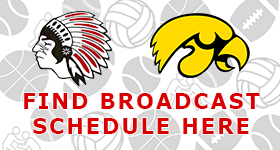Iowa DNR “Outdoors” Report for Week of June 28

Round Lake Wildlife Area is a gem hidden in plain sight
Round Lake Wildlife Area features 430 acres of wetlands, timber and prairie in western Harrison County. Photo courtesy of the Iowa DNR.
MONDAMIN – Round Lake has to be the easiest wildlife area to get to in the state. Sitting one mile east off of I-29 at the Hwy. 127 Mondamin exit, is the 430-acre mix of wetlands, timber and prairie in western Harrison County.
Primarily used by hunters, Round Lake can be especially good for duck hunting when the wetland has water, said Doug Chafa, wildlife biologist for the Iowa Department of Natural Resources Missouri River Wildlife Unit.
But hunting is only one aspect of Round Lake, Chafa said. Outside of hunting season, this old Missouri River oxbow offers kayaking in the summer, excellent morel mushroom hunting in the spring, and hiking on the firebreaks anytime.
“It’s not a huge area and because of that it probably gets overlooked a lot,” Chafa said. “But that’s part of its attraction – you don’t have the competition here.”
Chafa said the area is in transition and they are following the management plan that outlines removing non-target trees and converting the old ag fields into native prairie.
On the north end of Round Lake, two fields are in the awkward weedy stage all new prairie seedings go through while getting established, but a few prairie plants are beginning to show up. Foxglove beardtongue, giant cup plants, golden Alexanders, spider worts, rattlesnake master are identifiable. The plant diversity attracts bugs and those bugs feed birds. Two rooster pheasants crowed nearby.
The C-shaped oxbow opens to the west with a large peninsula stretching east. This area has a sunflower field for doves and food plots for deer and turkeys. Chafa is looking to remove some of the trees here, seed the area with native prairie plants and restore a two-acre basin to catch and collect water before entering the main wetland.
The local tenant handles the field work including installing the food plots, sunflower fields and planting cereal rye as a cover crop.
The cereal rye provides browse for deer and turkeys, and takes up nitrogen to prevent it from leaving the field, Chafa said. When the cover crop is terminated, the nitrogen is available for the food plot or sunflowers.
The oxbow wetland is ringed with cattails after two years of low water. On the northeast corner is the parking lot and boat ramp, and off the end of the ramp is a narrow pathway leading to the open water. Bullfrogs nervously scattered to the safety of the cattail edges, their bulging eyes barely visible through the duckweed. A wood duck flushed.
“The area is super attractive to migratory waterfowl, especially for snow geese in the spring, and for shorebirds in the spring and fall,” he said.
On this picture-perfect June morning, the Dickcissels were singing, a pelican soared high above while a brown thrasher flew away.
“There’s so much happening around Round Lake, it’s easy to get to and it’s not overrun with people,” Chafa said.
Battling unwanted invasive species
The Missouri River Wildlife Unit is working to remove invasive honeysuckle by treating it with roundup after the first frost of the fall. Honeysuckle stays greener later than native trees and shrubs allowing the roundup to knock back the unwanted invader.
Honeysuckle can choke out the understory and by removing it, sunlight will again reach the ground and encourage natural regeneration of the native cottonwoods. The staff is also battling leafy spurge and autumn olive on the area.
Round Lake’s lesser known wildlife species
Staff with the DNR’s Multiple Species Inventory and Monitoring program visited Round Lake in 2012 and 2016 to record the different species on the area.
In addition to the deer, wild turkeys, rabbits and pheasants that live here, there are a number of species that are considered in need of greatest conservation including prairie ringneck snakes, tiger salamanders, northern prairie skinks, Baltimore orioles, belted kingfishers, brown thrashers, dickcissels, northern harriers, red-headed woodpeckers, Eastern wood-pewee, yellow-billed cuckoos and regal fritillary and monarch butterflies.
Media Contact: Doug Chafa, Wildlife Biologist, Iowa Department of Natural Resources, 712-420-2437.
Stay safe paddling this 4th of July holiday weekend
Iowa lakes and rivers will be busy with paddlers this long holiday weekend.
Paddlers can enjoy water trails that currently span 36 counties across the state via streams and lakes of all sizes and lengths. Iowa has 18,000 miles of navigable waterways, and no shortage of streams and lakes to paddle.
Check the Iowa DNR’s interactive paddling map (www.iowadnr.gov/Things-to-Do/Canoeing-Kayaking/Where-to-Paddle) for updates on real-time hazards like downed trees and log jams, strainers and bridge construction.
“The number one hazard on the river is strainers,” said Todd Robertson, paddling instructor and Outreach Coordinator for Rivers Programs at the Iowa DNR. “Piles of trees and branches can suck a paddler in and under with little chance of escape.”
Stay safe this holiday weekend and each time you paddle with these simple safety tips.
- Always wear your life jacket. Kids 12 and under must wear a life jacket at all times when underway on a recreational vessel on any Iowa water. It’s also law that those 13 and over, if not wearing their life jacket, must have a life jacket on board their vessel.
- Learn about and study your route in advance. Be able to read the water and effectively steer and propel your boat.
- Paddle with a group, not by yourself.
- Tell a friend or loved one where you will be paddling, including what access to what access, and when you are expected to return. It will be easier to find you if you need help.
- Bring along a dry bag with a set of extra clothes you can change into if you get wet, a first-aid kit and a protected cell phone or weather radio.
- Pack plenty of water to stay hydrated. Wear light, loose fitting clothing that dries quickly. Wear a hat, sunglasses and plenty of sunscreen.
- Explore the Iowa DNR’s water trail map library at www.iowadnr.gov/Things-to-Do/Canoeing-Kayaking/Water-Trail-Maps-Brochures for individual water trail maps, including access points and some history information.
Media Contact: Todd Robertson, Iowa DNR River Programs Outreach Coordinator, 515-205-6845 or [email protected].
Fourth of July weekend looking good for state park visitors
Iowa State Parks are gearing up for the Fourth of July weekend as thousands of campers, cabin renters, picnickers and outdoor enthusiasts get ready to enjoy the long weekend.
“State Parks are great destinations for summer holidays,” says Sherry Arntzen DNR State Parks, Forests and Preserves Bureau chief. “Whether you are staying for a week or making a day trip, our parks and forests provide great opportunities for families and friends to make memories.”
Last-minute campers can take their chances with walk-in campsites, as 25 percent of all state park campsites are first-come, first-served, except at Lake Manawa, Maquoketa Caves, and Walnut Woods state parks, which are 100 percent reservable. Most of the sites available are non-electric; realistically, most will be occupied by this Thursday. The best chances to secure a site will be at smaller, more remote parks. Visit https://www.iowadnr.gov/Places-to-Go/State-Parks/Iowa-State-Parks for a list of parks and amenities.
Here are additional tips for an enjoyable and safe visit to Iowa state parks this holiday:
Parking: Expect large crowds, be patient and plan accordingly. Consider coming early in the morning or late in the afternoon. Parking is not allowed on roadways (only in designated areas). Please follow all road signs, especially speed limits, to keep everyone safe.
Fireworks: Individuals are allowed to use “novelties,” which include party poppers, snappers, toy smoke devices, snakes, glow worms, wire sparklers and dipped sticks. All other fireworks are banned in state parks without a special event “fireworks” permit.
Water safety: Park beaches will be very popular. Be aware of surroundings, stay in designated swimming areas, and keep your eyes at all times on members of your group who are swimming. Most state park beaches do not have lifeguards, so be vigilant. Consider life jackets for any children who may not be able to swim.
Stay cool: Heat and crowds can take their toll. Drink plenty of water, wear sunscreen and avoid excessive alcohol use.
Be a good neighbor: Everyone wants to have a good time. Be courteous, pick up trash and be patient with other visitors. If you need assistance or see something concerning, please contact the park office. In case of emergency, call 911.
Alerts and closure information is posted on the DNR website at www.iowadnr.gov/parks and the parks reservation system at http://iowastateparks.reserveamerica.com. Current information is also available by calling individual park offices directly.
Media Contact: Sherry Arntzen, State Parks, Forests and Preserves Bureau Chief, 515- 346-7036.
Lake Manawa State Park opens new campground
COUNCIL BLUFFS – The new campground at Lake Manawa State Park has opened.
The 40-campsite campground features modern amenities including full hook-up campsites, a shower house, and a paved walking trail connecting the campground to the beach and Dreamland Playground. It also features a gated entrance for campers to access the campground.
A registration building at the campground gate provides online and telephone reservation information for those who come to the park looking for a site. Campers will receive a four-digit access code to open the gate and enter the campground.
All 40 campsites are available for online reservations; walk-in sites will not be an option.
“Lake Manawa is the third Iowa state park to offer 100 percent reservable campsites,” said Sherry Arntzen, chief of the Parks, Forests and Preserves Bureau. “Campers have been pleased with the flexibility and convenience it provides and we are excited to offer this feature and for campers to enjoy this beautiful new campground.”
With 100-percent reservable sites, availability is known in real time. Campers can search and book sites online before leaving home, on the way to the park, or at the campground. Reservations can be made from April 15 to October 15 until 9 p.m. CST the day of arrival online at https://iowastateparks.reserveamerica.com/ or by calling the reservation call center at (877) 427-2757 Mondays through Fridays from 7 a.m. to 7 p.m., and Saturdays from 8 a.m. to 4 p.m.; the call center is closed on Sundays.
Customers will no longer need to fill out the paper walk-in registration forms or pay with cash or check; all reservations will require a credit card payment online or over the phone. Customers can still pay by check if the reservation is made through the call center and made at least 21 days in advance.
Construction began on the campground in fall 2020. It officially opened on June 1.
Out-of-state user permits required for Lake Manawa, Waubonsie state parks
The Iowa Legislature has extended the out-of-state user permit requirement for Lake Manawa and Waubonsie state parks through December 31, 2025. The law also changes the expiration date for annual permits from one year from the date of purchase, to the end of the calendar year.
Annual permits purchased January 1 – June 30, 2022 will be honored into 2023, expiring one year from purchase date. Annual permits purchased starting July 1, 2022 will be valid until the end of 2022.
The daily permit for out-of-state visitors costs $5 and an annual permit is $40. Daily passes can be purchased at pay stations throughout the park. More information can be found at: https://www.iowadnr.gov/Places-to-Go/Nonresident-Vehicle-Entrance-Permits
Media Contact: Michelle Reining, Southwest District Supervisor, Iowa DNR, 515-250-2222 or [email protected].




